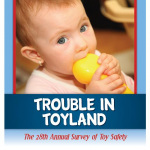
Trouble in Toyland
The 28th Annual Review of Toy Safety
The 2013 Trouble in Toyland report is the 28th annual NJPIRG survey of toy safety. In this report, NJPIRG provides safety guidelines for consumers when purchasing toys for small children and provides examples of toys currently on store shelves that may pose potential safety hazards.
Downloads
NJPIRG Law & Policy Center

The 2013 Trouble in Toyland report is the 28th annual NJPIRG survey of toy safety. In this report, NJPIRG provides safety guidelines for consumers when purchasing toys for small children and provides examples of toys currently on store shelves that may pose potential safety hazards.
Over the past twenty-eight years, our report has identified hazards in toys and children’s products that could cause acute injuries, from choking hazards from toys with small parts, to strangulation hazards from cords on pull toys, to laceration hazards from edges that are too sharp, to toxic hazards posed by chemicals in toys. Our report has led to more than 150 recalls and other regulatory actions over the years, and has helped educate the public and policymakers on the need for stronger public health and consumer safety standards to protect children from unsafe products. This report continues to help keep children – particularly babies and toddlers – safe, as the majority of all injuries happen to children in the 0-2 age range.
The enactment of the Consumer Product Safety Improvement Act (CPSIA) of 2008 made great strides in toy safety and strengthened the ability of the Consumer Product Safety Commission (CPSC) to protect consumers, including the littlest consumers—children. Although policymakers delayed implementation of its most stringent lead standard rules and enacted some narrow exceptions in 2011, on the whole the law has been protected from attempts to undermine it. However, we remain vigilant as a variety of regulatory threats to the CPSC’s tools and authority remain under consideration by policymakers.
Parents should be vigilant this holiday season, and remember:
- The CPSC does not test all toys, and not all toys on store shelves meet CPSC standards. There is no comprehensive list of potentially hazardous toys. Examine toys carefully for potential dangers before you make a purchase. Shop with NJPIRG’s Toy Safety Tips available at www.ToySafetyTips.org and on our website, www.njpirg.org.
- Parents should continue to be vigilant about metals in toys as they may contain lead or cadmium above the mandatory safety limits. The Centers for Disease Control (CDC) recommends that all children be screened for exposure to lead. A simple and inexpensive blood test can determine whether or not a child has a dangerous level of lead in his or her body. The test can be obtained through a physician or public health agency.
- Report unsafe toys or toy-related injuries to the CPSC at www.cpsc.gov and www.saferproducts.gov or call the CPSC at 1-800-638-2772.
Topics
Find Out More


What the New Jersey Privacy Act means for you

5 steps you can take to protect your privacy now
